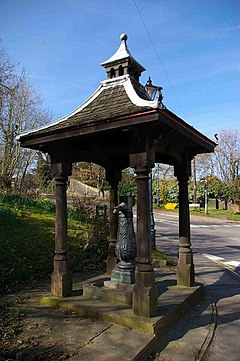Watton-at-Stone
| Watton-at-Stone | |
|---|---|
 Village cast iron water pump, dating from the early 19th century |
|
| Watton-at-Stone shown within Hertfordshire | |
| Population | 2,272 (2011 Census including Whempstead) |
| OS grid reference | TL299194 |
| District | |
| Shire county | |
| Region | |
| Country | England |
| Sovereign state | United Kingdom |
| Post town | HERTFORD |
| Postcode district | SG14 |
| Dialling code | 01920 |
| Police | Hertfordshire |
| Fire | Hertfordshire |
| Ambulance | East of England |
| EU Parliament | East of England |
| UK Parliament | |
Watton-at-Stone is a village in the English county of Hertfordshire, situated midway between the towns of Stevenage and Hertford in the valley of the River Beane. The 2011 census showed a population of 2,272 living in 946 households. Watton-at-Stone is also a civil parish in East Hertfordshire District Council.
There is little employment directly within the village and it largely serves as a dormitory for commuters to London or to the nearby towns with hourly trains to Moorgate station.
The village has a primary school and nursery school. The co-educational Heath Mount independent school is located on the outskirts in the private estate of the Grade II* listed Woodhall Park.
The A602 formerly ran through the centre of the village between Stevenage and Hertford before a bypass was built in the 1980s through farmland to the north-east. The section of the road to Hertford was renamed the A119, and the A602 then ran out of Watton-at-Stone to Ware. Watton-at-Stone is served by a railway station on the Hertford Loop Line. The station opened for passengers on 2 June 1924, was closed on 11 September 1939 (though the line continued to run through the village), and reopened on 17 May 1982, paid for partly by public subscription.
A war memorial lies in a field adjoining the church.
In the village itself there is a small convenience store, café and takeaway restaurant as well as a hairdressers.
The name Watton first appeared in writing in an 11th-century publication of 10th century Anglo-Saxon wills as Wattun. It was later recorded in the Domesday Book as both Wodtune and Watone. The origin of the word is uncertain, and is variously ascribed to Old English wád or woad, and ton meaning small farming settlement; or waden meaning ford; or from waétan meaning watery. The suffix -at-Stone dates from the early 13th century and may be derived from the presence of two large examples of Hertfordshire puddingstone, now situated at the Waggon and Horses public house.
...
Wikipedia

